Massachusetts’ mountains are undeniably epic in their stature and diverse ecosystems. 1,173 peaks reach for Massachusetts’ sky, but one of the most interesting is Mount Tom on the Connecticut River‘s banks. So, how tall is Mount Tom in Massachusetts? Discover how high this epic peak stands and how its unusual geology provides habitats for a wide range of flora and fauna.
How Tall is Mount Tom in Massachusetts?
Mount Tom in Massachusetts is 1,202 feet tall. It’s the tallest of the Mount Tom range and Metacomet Ridge’s highest traprock peak. Folks often refer to the whole ridge as Mount Tom.
1,202 feet tall, Mount Tom is the southernmost peak in the Mount Tom range. It’s situated in Easthampton and Holyoke on the Connecticut River’s west bank. It’s a popular recreation area, and three local television transmitters are located there.
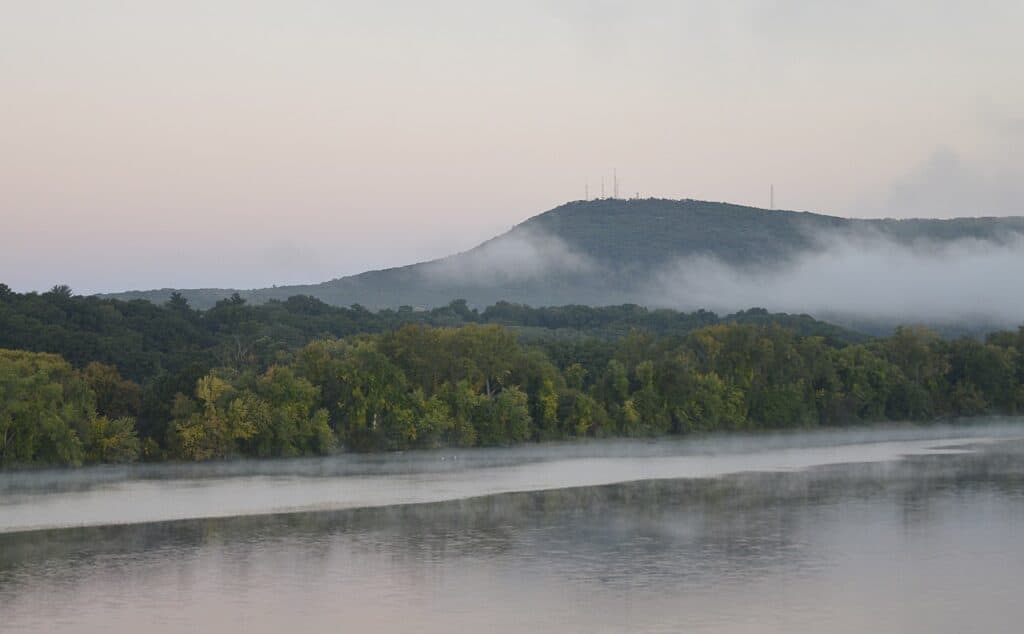
Massachusetts’ Mount Tom is 1,202 feet tall.
©Simtropolitan / public domain – License
What Is Mount Tom Known For?
Mount Tom got its name from 1660’s surveyor Rowland Thomas. Thomas modestly named the peak after himself, whilst his colleague Elizur Holyoke chose the opposing mount. Legend has it that Mount Tom’s steep silhouette inspired How The Grinch Stole Christmas’ Mount Crumpet.
The area is famous for its line of high-rise 1,100-foot tall cliffs that tower over the Connecticut River valley. Its cliff faces and scree slopes are attractive landscape features. Mount Tom’s range rises steeply over the river and runs for 45 miles. It’s a rugged space with fascinating mini-ecosystems and microclimates.
Over the years, various building projects stalled on Mount Tom Range, such as the haunting ruins of the first hotel on the summit of Mount Tom and the huge Eyrie house ruins that burned down in 1901.
In 1946, a U.S. Air Force Flying Fortress plane hit the northern mountain range, killing all 25 passengers. Pieces of the place still sit there, and a granite memorial plus a benchmark on the spot. If you’re hiking Mount Tom and find wreckage, it’s the custom to place it on the rock wall next to the memorial.

The Connecticut River runs past Mount Tom.
©Joshua Lehew/Shutterstock.com
How Does It Compare to Nearby Peaks?
How does Mount Tom compare to the Mount Tom range peaks? Well, it’s taller!
- Whiting Peak: 1,014 feet tall.
- Goat Peak: 882 feet tall with a raptor observation platform.
- Dry Knoll: 835 feet tall.
- Mount Nonotuck: 827 feet tall and the location of Eyrie House ruins.
Is Mount Tom in Massachusetts?
1,202 feet tall Mount Tom in Massachusetts is not the only Mount Tom in the United States. 42 other Mount Toms exist! For example, California’s Mount Tom rises 1,972 feet, and Washington State’s Mount Tom towers 7,076 feet over the Olympic National Park.
What Is Massachusetts’ Tallest Peak?
Northwest Massachusetts’ Mount Greylock is the highest peak at 3,489 feet tall. It’s part of the Appalachian Mountain sub-range, the Taconic Mountains. Legend says its white profile, which resembles a sperm whale breaching the ocean, inspired Herman Melville’s novel Moby Dick. Mount Greylock Road has a 10-12% incline that’s popular with cyclists because it’s the steepest in the county.

Mount Greylock is Massachusetts’s tallest peak.
©Romiana Lee/Shutterstock.com
At the other end of the scale is Massachusetts’ lowest spot, the Atlantic Ocean coastline at 0 feet above sea level.
Tallest Peak in North America
Mount Tom reaches 1,202 feet tall, which makes it a tiddler compared to North America’s tallest mountain, 20,310 feet above sea level, Denali, also called Mount McKinley. Denali towers above south-central Alaska.
Can You Drive Up Mount Tom?
Mount Tom and its surrounding range are rugged. It’s perfect for well-trained hikers who can spend all day traversing the slopes admiring the unusual flora and fauna found there (more on that later). Unless you fancy cross-country skiing or at least investing in snow shoes, it’s best to visit in summer because, during the winter months, heavy snowfall and frost cover the trails.
Drive to trailhead parking lots in the Mount Tom State reservation off Route 5 in Easthampton or Route 141 in Holyoake.
What Is There to Do on Mount Tom?
Mount Tom is popular with hikers, anglers, bird watchers, skiers, paragliders, and geocachers. Across the whole 110 miles of Metacomet-Monadnock Trail, that Mount Tom is part of, lies maintained trails and a park road that’s maintained by the Berkshire Chapter of the Appalachian Mountain Club.

Cross-country skiing is popular on Mount Tom during the winter months.
©Christopher Tipton/Shutterstock.com
Mount Tom’s Ecology
Volcanic basalt formed Mount Tom. It’s also called traprock or trap rock, a dark-colored igneous rock built from layers of cooling lava that forms steps. The name traprock is taken from the Swedish trappa for stair.
Experts think Mount Tom formed when the North American continent tore away from Eurasia and Africa in the Triassic Period. Tectonic activity spilled lava, eventually creating layers of traprock that Mount Tom is known for.
It’s these cooled lava layers that form Mount Tom’s varied ecosystems and microclimates. Its diverse hot upper slopes, cool ravines, open meadows, deep waterways, shallow wetlands, vernal pools, and cliff ledges house various species. Its special status is cemented by Mount Tom State Reservation, which conserves the area.
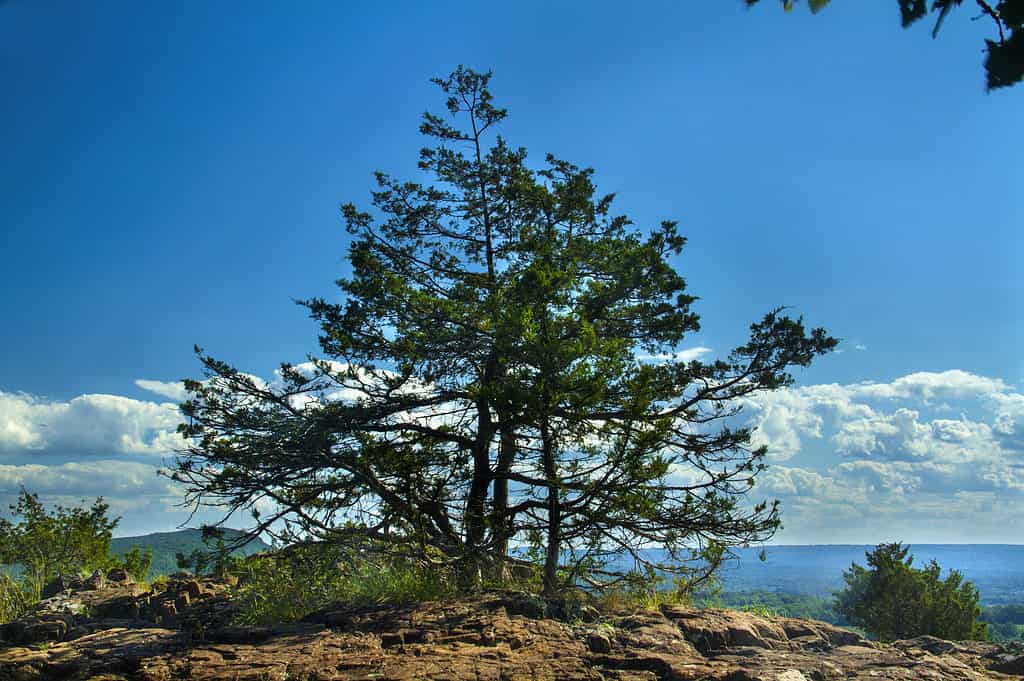
Mount Tom’s diverse habitats formed from traprock, which is layers of cooled lava.
©iStock.com/Holcy
What Wildlife Is on Mount Tom?
Mount Tom range’s microclimates create rare habitats. The state-protected list includes threatened marbled salamanders and the wood turtle. It’s also an extremely important seasonal raptor migration pathway.
What might you see up there?
Kestrels
Raptor lovers keenly watch kestrels on Mount Tom. Their nesting box program annually documents hatching chicks and mated pairs.
Kestrels eat small rodents, lizards, and insects, and they reach 39 mph when diving. They prefer to nest in rocky crevices, which is one of the reasons why their population is so large on Mount Tom.
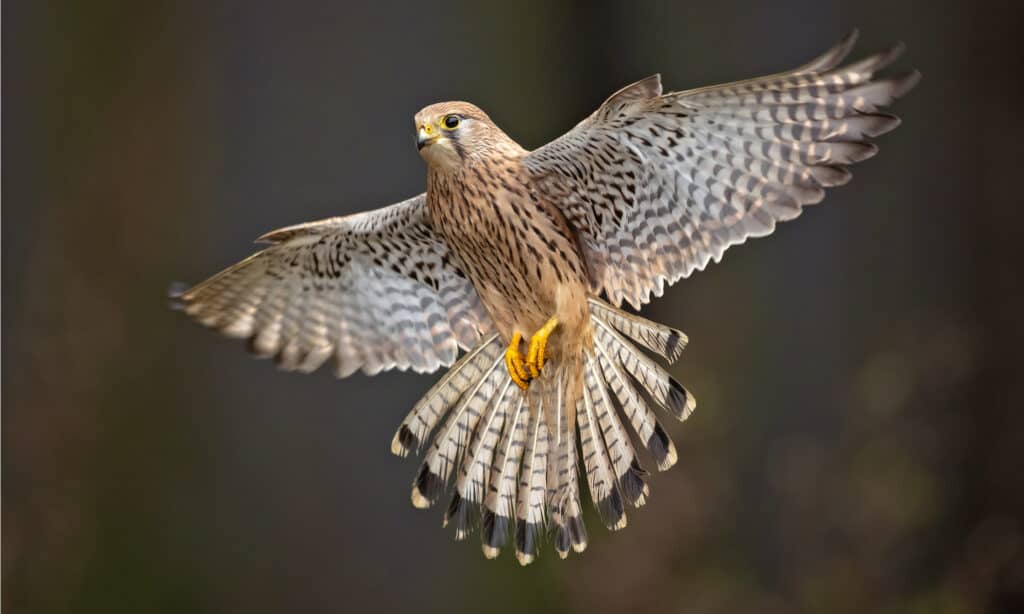
Kestrels prefer to nest in rocky crevices, which is why Mount Tom is such a good spot for them.
©Milan Zygmunt/Shutterstock.com
Bobcats
Solitary bobcats prowl Mount Tom, hunting down rabbits and birds. Most people hear them first, or a lucky few spot them at dawn or dusk because these nocturnal hunters don’t appreciate human company.
Measuring 25-40 inches long and up to 22 pounds, short-tailed spotty bobcats are fairly small and not much of a threat to humans. However, should one stalk you, make lots of noise, and move to scare them off.
North American Black Bear
Black bears on the other hand, are dangerous to humans. On Mount Tom, omnivorous black bears search out berries, shoots, and vegetation and hunt white-tailed deer. It’s thought 4,500 black bears live in Massachusetts’ forested areas, making Mount Tom a hot spot.
Formidable black bears weigh between 130 and 600 pounds, run at 30 mph, and reach around 4.5 feet long. They generally keep their distance from humans, but it’s important to keep your wits about you on Mount Tom, your dog on a leash, and carry bear spray. Here’s how to survive a rare black bear attack.
North American Porcupine
Quirky North American porcupines live on Mount Tom in its dense forested areas. They’re not a problem for humans, but an over-enthusiastic dog will come off worse! A porcupine’s large quills effectively fend off predators.
Weighing 12-35 pounds and chiefly dark brown with white patches, vegetarian porcupines feast on nuts, fruits, twigs, roots, and tubers. In spring, mother porcupines lead cute babies on walks to learn foraging skills.
Did you know porcupines climb trees? It helps them evade predators like bears and bobcats. Sometimes, porcupines build nests in the safety of tree branches.

Porcupines are good climbers. They sometimes nest in trees.
©iStock.com/Wirestock
Red-Tailed Hawks
Mount Tom is a raptor spotter’s paradise, and red-tailed hawks are plentiful there. Screaming red-tailed hawks hunt small mammals and birds, swopping from the sky to pin down their unfortunate prey before they even know the hawk is there.
On average, red-tailed hawks weigh two to four pounds, but their wingspan can reach 52 inches! Chiefly brown, these hawks have white-streaked undersides and burgundy red tails.
Spotted Salamanders
Threatened marbled salamanders call Mount Tom home, but hikers are more likely to spot more common salamanders, such as the spotted species. The yellow spotted salamander is dark gray or black with yellow spots running its spine length.
Six to ten-inch-long salamanders live beneath Mount Tom’s rocks and in its leaf litter, but in spring, they use vernal pools to breed. Vernal pools dry up in summer, so it’s a race again time to lay eggs. Mount Tom’s vernal pools also contain fairy shrimp, a tasty food source for wood frogs. Salamanders eat both!
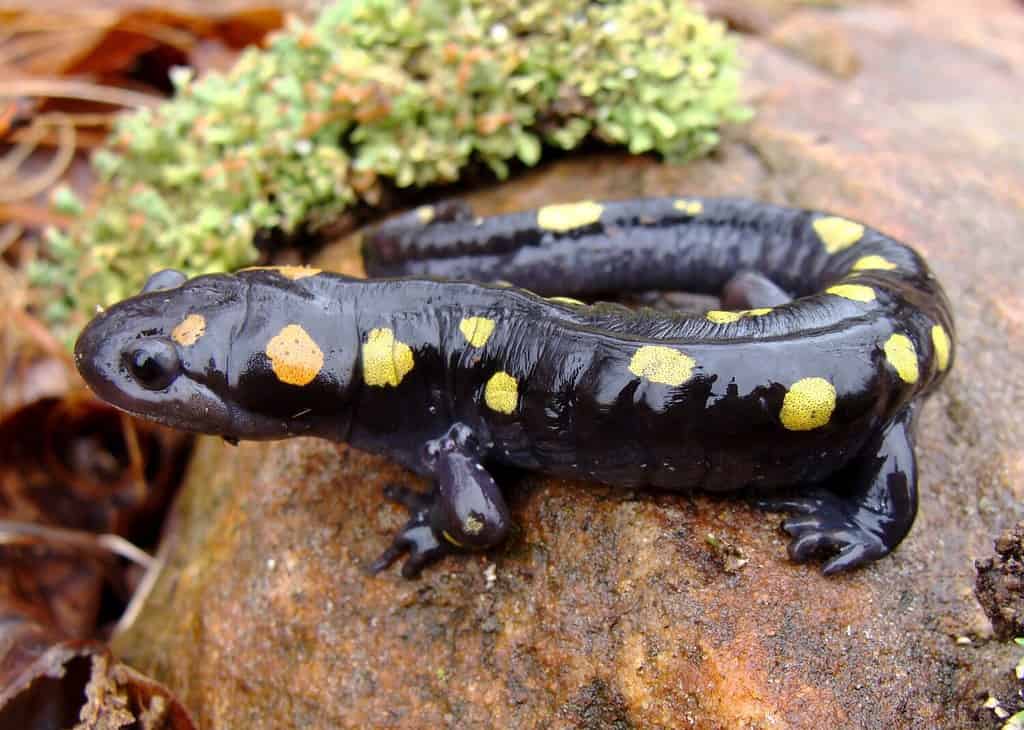
Yellow-spotted salamanders eat fairy shrimp and small frogs on Mount Tom.
©Matt Jeppson/Shutterstock.com
White-Tailed Deer
A frequent spot on Mount Tom, white-tailed deer weigh between 150 and 600 pounds, up to 7.2 feet long, and 4 feet tall. White-tailed deer are instantly recognizable with their brown coats and uplifted whitetails.
They prefer forests or wooded areas, but when startled, they can run at 30 mph and jump 10-foot tall barriers. White-tailed deer browse and graze on vegetation, stripping tree bark in the lean winter months.
Snakes
Massachusetts is home to 15 snake species, but most are harmless, small, and non-threatening. However, on Mount Tom, look out for two venomous species: the timber rattlesnake and northern copperhead.
Timber rattlesnakes tend to occupy forests from spring to fall and hibernate over winter. They bask on rocky, sunny spots and announce their presence with a distinctive tail rattle. Northern copperheads don’t rattle but appear seasonally too. Copperheads reach five feet long; they’re the largest Massachusetts snake.
Both venomous snakes are rare in Massachusetts, but it’s important to wear hiking boots at all times and watch where your hands go.
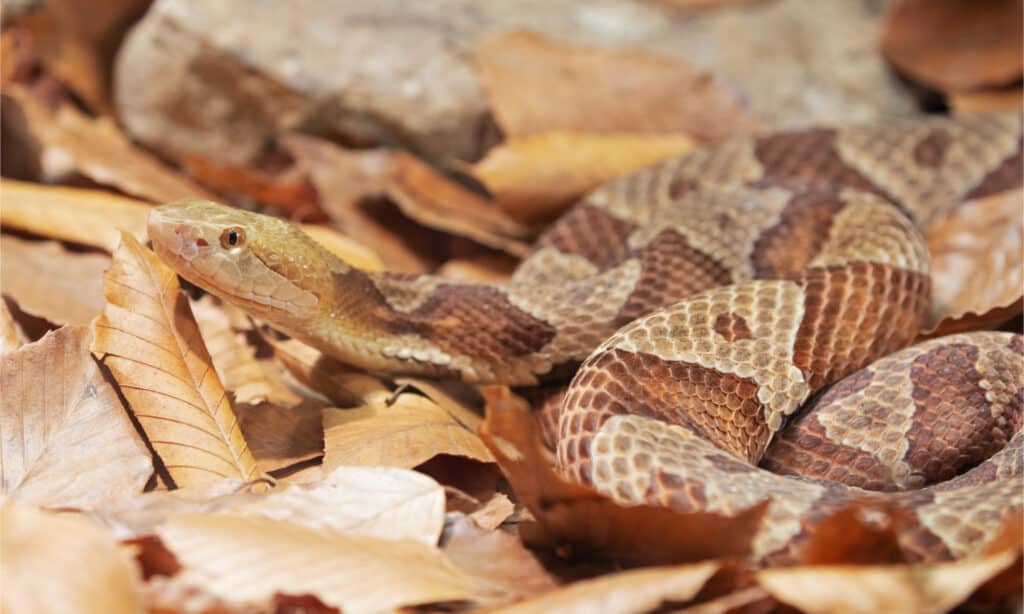
Northern copperhead snakes are rare on Mount Tom, but they blend into leaf litter.
©DnDavis/Shutterstock.com
Interesting Plants on Mount Tom
Mount Tom’s plants include oak savannahs on its hot, dry ridges, such as the chestnut oak. Other magnificent trees include eastern red cedar, northern hardwood, oak-hickory forests, and eastern hemlock. Cool ridges, vernal pools, and crevices house ferns and beautiful trout lilies.
On the state protection list, herbaceous perennial wildflower swamp lousewort got the unattractive name from its perceived ability to prevent lice in farm animals. It’s actually a pretty fern-like wildflower with white-yellow blooms.
Green rock cress is a threatened eight to 20-inch tall biennial herb that loves acid ledges and rocky ground. It’s legally protected against damage or poaching in Massachusetts.
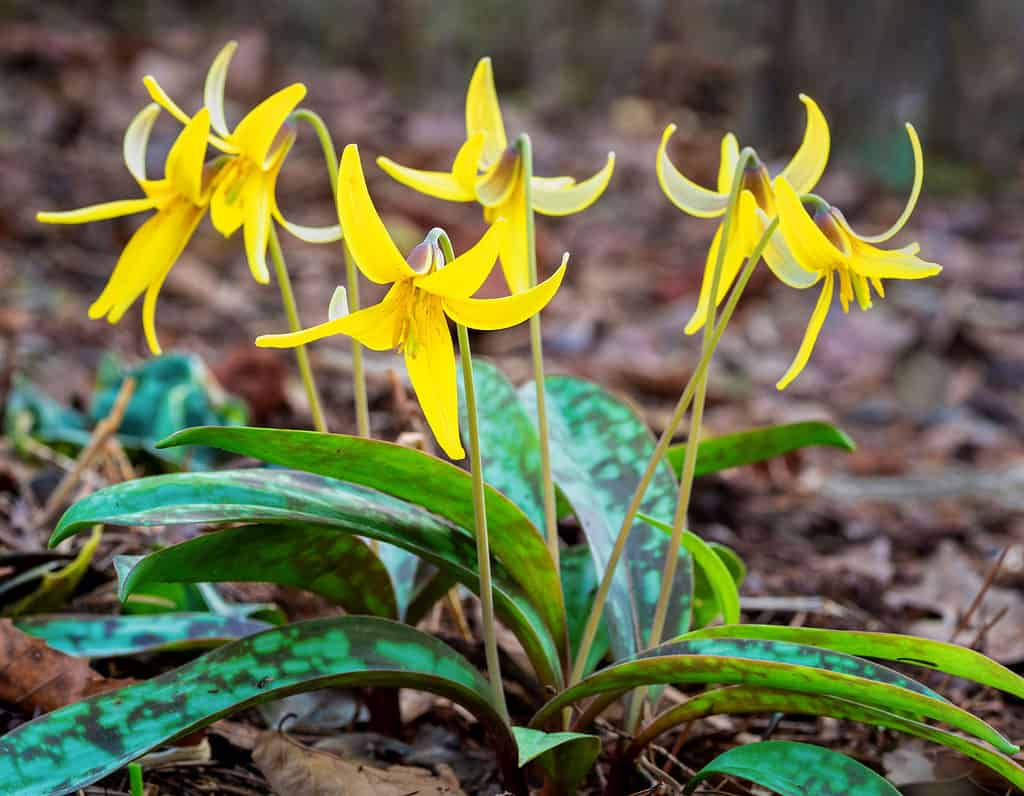
Beautiful trout lily thrives in Mount Tom’s cool, shaded ridges near vernal ponds.
©Gerry Bishop/Shutterstock.com
Is There Ever Wildfire on Mount Tom?
Wildfire is always a threat in hot and dry conditions. Although Mount Tom isn’t known for wildfire, and its fire observation tower is no longer standing, it’s still a potential hazard. Visitors can check before heading out.
The photo featured at the top of this post is © BestStockFoto/Shutterstock.com
Thank you for reading! Have some feedback for us? Contact the AZ Animals editorial team.







